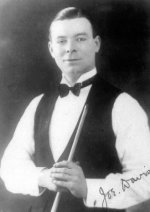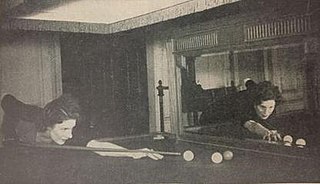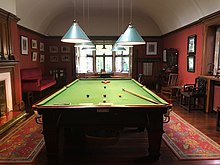
The World Snooker Championship is the longest-running and most prestigious tournament in professional snooker. It is also the richest, with total prize money of £2,395,000 in 2023, including £500,000 for the winner. First held in 1927, it is now one of the three tournaments that make up snooker's Triple Crown Series. The reigning world champion is Luca Brecel.

Joseph Davis was an English professional snooker and English billiards player. He was the dominant figure in snooker from the 1920s to the 1950s, and has been credited with inventing aspects of the way the game is now played, such as break-building. With the help of equipment manufacturer Bill Camkin, he drove the creation of the World Snooker Championship by persuading the Billiards Association and Control Council to recognise an official professional snooker championship in 1927. Davis won the first 15 world championships from 1927 to 1946, and he is the only undefeated player in World Snooker Championship history. In 1930, he scored the championship's first century break.

Herbert John Pulman was an English professional snooker player who was the World Snooker Champion from 1957 to 1968. He won the title at the 1957 Championship and retained it across seven challenges from 1964 to 1968, three of them against Fred Davis and two against Rex Williams. When the tournament reverted to a knockout event in 1969 he lost 18–25 in the first round to the eventual champion John Spencer, and he was runner-up to Ray Reardon in 1970. He never reached the final again, although he was a losing semi-finalist in 1977.
Desmond Rex Williams is an English retired professional snooker and billiards player. He was the second player to make an official maximum break, achieving this in an exhibition match in December 1965. Williams won the World Professional Billiards Championship from Clark McConachy in 1968, the first time that the title had been contested since 1951. Williams retained the title in several challenge matches in the 1970s, and, after losing it to Fred Davis in 1980, regained it from 1982 to 1983.
The 1927 World Snooker Championship was a snooker tournament held at several venues from 29 November 1926 to 12 May 1927. At the time, it was titled the Professional Championship of Snooker but it is now recognised as the inaugural edition of the World Snooker Championship. The impetus for the championship came from professional English billiards player Joe Davis and billiard hall manager Bill Camkin, who had both observed the growing popularity of snooker, and proposed the event to the Billiards Association and Control Council. Ten players entered the competition, including most of the leading English billiards players. The two matches in the preliminary round were held at Thurston's Hall in London, and the semi-finals and final took place at Camkin's Hall in Birmingham. The players involved determined the venues for the quarter-finals, resulting in matches in London, Birmingham, Nottingham and Liverpool.
Since 1927 the World Snooker Championship had been played as a single-elimination tournament, but between 1964 and 1968, it was defended over seven challenge matches. Following a hiatus after the 1957 World Professional Match-play Championship, the event was revived by Rex Williams on a challenge basis, with the champion being opposed by prominent players. This began in 1964, organised by the Billiards Association and Control Council. The 1957 champion John Pulman contested and won all seven challenge matches against various opponents in the next five years, until the tournament reverted to a knock-out format in 1969.

Tom Reece was an English professional player of English billiards. He was six times runner-up in the professional billiards championship, now regarded as the world championship, losing three times to Melbourne Inman in finals from 1912 to 1914, and three times to Tom Newman in the 1921, 1924 and 1925 finals. He made the unofficial world's highest billiards break of 499,135 in 1907 using a cradle cannon technique shortly before it was banned from the sport. In 1927, his prowess with the pendulum stroke led to that also being banned from use in competition.
The News of the World Snooker Tournament was one of the leading professional tournaments of the 1950s, widely considered as more important than the world championship due to the involvement of Joe Davis. The event was sponsored by the Sunday newspaper News of the World. The highest break of the tournament was 140 or more on four occasions, which was unusual at that time.
The English Amateur Championship, an annual snooker competition, is the highest-ranking and most prestigious amateur event in England. It is also the oldest and longest-running snooker tournament in the world, having been established in 1916, a full 11 years before the World Snooker Championship.
The 1930 World Snooker Championship, known at the time as the Professional Championship of Snooker, was a snooker tournament held between 17 March and 23 May 1930 at various venues in England, with the final taking place from 19 to 24 May at Thurston's Hall, London. Defending champion Joe Davis won the title for the fourth time by defeating Tom Dennis by 25 frames to 12 in the final.
The 1933 World Snooker Championship, known at the time as the Professional Championship of Snooker, was a snooker tournament held between 23 March and 16 June at various venues in England, with the final beginning on 12 June 1933 at Joe Davis's Saloon in Chesterfield, England. It was the seventh edition of the championship, and Joe Davis won his seventh title by defeating Willie Smith by 25 frames to 18 in the final. The highest break of the tournament was 72, compiled by Davis in the fortieth frame of the final.
The 1935 World Snooker Championship was a snooker tournament held at Thurston's Hall in London, England from 8 to 27 April 1935. It was the first edition of the Championship to incorporate "world" in its name, being called the World's Professional Snooker Championship. Joe Davis won the title for the ninth time by defeating Willie Smith by 28 frames to 21 in the final, having achieved a winning margin at 25–20. Davis recorded the first century break in the history of the championship, a 110 in his semi-final match against Tom Newman.
The 1936 World Snooker Championship was a snooker tournament that was held at the Burroughes and Thurston's Halls in London, England from 23 March to 2 May 1936. There were 13 entries; a significant increase from five in the previous year and just two in 1934. Defending champion Joe Davis won the Championship for the tenth consecutive time, defeating Horace Lindrum in the final 34–27. Horace Lindrum became the first Australian to compete at the World Championship and made the only century break of the tournament, a 101 in his semi-final match against Stanley Newman.
The 1947 World Snooker Championship was a professional snooker tournament that took place from 20 January to 25 October 1947. The final was held at the Leicester Square Hall in London, England, from 13 to 25 October. The semi-finals were completed in March, but the final was delayed due to building works at the venue, which had been bombed in October 1940. Walter Donaldson won the title by defeating Fred Davis by 82 frames to 63 in the final, although he reached the winning margin earlier, at 73–49. Davis made the highest break of the tournament with a 135 clearance in frame 86 of the final.
The 1948 World Snooker Championship was a professional snooker tournament that took place from 9 March to 1 May 1948. It was an edition of the World Snooker Championship first held in 1927. A qualifying event with eight participants was held from 1 to 13 December 1947 at Burroughes Hall and was won by John Pulman, who joined seven other players in the main event.
Fred Lawrence 18 June 1887 – 4 January 1964 was an English Billiards and snooker player. In 1919 he won a second-class professional billiards tournament at Thurston's Hall. He won the Midland Counties Billiards Championship in 1920, and 1921. Lawrence lost 13 - 16 to Joe Davis in the final of the 1928 World Snooker Championship.

Thurston's Hall was a major billiards and snooker venue between 1901 and 1955 in Leicester Square, London. The hall was in the premises of Thurston & Co. Ltd which relocated to Leicester Square in 1901. The building was bombed in 1940 and reopened under a new name, Leicester Square Hall, and new management in 1947. The venue closed in 1955 and the building was demolished to make way for an extension to Fanum House. The Hall was used for many important billiards and snooker matches, including 12 World Snooker Championship finals between 1930 and 1953. It was also the venue of the first World Snooker Championship match in November 1926. The hall was sometimes referred to as "Thurston's Grand Hall". There was also a "Minor Hall" in the same building.

Joyce Gardner (1910–1981) was an English professional English billiards player. She was the Women's Professional Billiards Champion from 1931 to 1933, and from 1935 to 1938.
The Women's Professional Billiards Championship was an English billiards tournament held from 1930 to 1950. The tournament was first organised by Burroughes and Watts in 1930 and 1931, before the WBA ran the event until its conclusion in 1950. Joyce Gardner won the tournament on seven of the fourteen times that it was held, and was runner-up six times; the only time that she was not in the final was the 1940 tournament. The other players to hold the title were Thelma Carpenter who won four times, and Ruth Harrison who took three championship titles. Harrison's break of 197 in 1937 remains a women's record in competitive billiards.
The 1908 American Tournament was the name for professional English Billiards and snooker tournaments held from October 1907 to March 1908 at Burroughes Hall. Seven professional players participated in round-robin tournaments for each sport. Tom Reece won the billiards title after defeating Charles Dawson 8,000–6,010 in a play-off final after each of them had won five group matches. Dawson won the snooker championship, with Cecil Harverson the runner-up.







